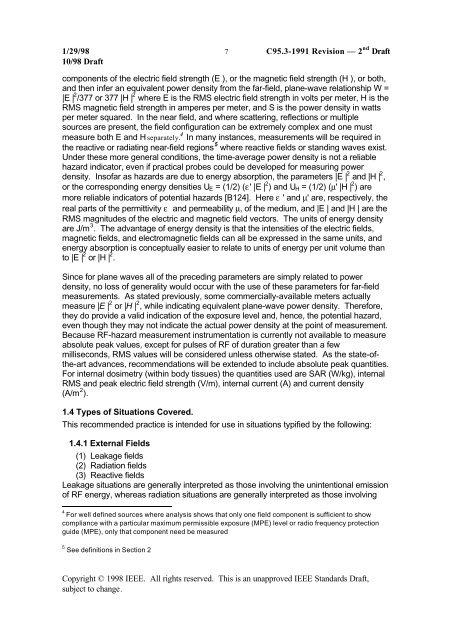DRAFT Recommended Practice for Measurements and ...
DRAFT Recommended Practice for Measurements and ...
DRAFT Recommended Practice for Measurements and ...
Create successful ePaper yourself
Turn your PDF publications into a flip-book with our unique Google optimized e-Paper software.
1/29/98 7 C95.3-1991 Revision — 2 nd Draft<br />
10/98 Draft<br />
components of the electric field strength (E ), or the magnetic field strength (H ), or both,<br />
<strong>and</strong> then infer an equivalent power density from the far-field, plane-wave relationship W =<br />
|E | 2 /377 or 377 |H | 2 where E is the RMS electric field strength in volts per meter, H is the<br />
RMS magnetic field strength in amperes per meter, <strong>and</strong> S is the power density in watts<br />
per meter squared. In the near field, <strong>and</strong> where scattering, reflections or multiple<br />
sources are present, the field configuration can be extremely complex <strong>and</strong> one must<br />
measure both E <strong>and</strong> H separately. 4 In many instances, measurements will be required in<br />
the reactive or radiating near-field regions 5 where reactive fields or st<strong>and</strong>ing waves exist.<br />
Under these more general conditions, the time-average power density is not a reliable<br />
hazard indicator, even if practical probes could be developed <strong>for</strong> measuring power<br />
density. Insofar as hazards are due to energy absorption, the parameters |E | 2 <strong>and</strong> |H | 2 ,<br />
or the corresponding energy densities U E = (1/2) (ε' |E | 2 ) <strong>and</strong> U H = (1/2) (µ' |H | 2 ) are<br />
more reliable indicators of potential hazards [B124]. Here ε ' <strong>and</strong> µ' are, respectively, the<br />
real parts of the permittivity ε <strong>and</strong> permeability µ, of the medium, <strong>and</strong> |E | <strong>and</strong> |H | are the<br />
RMS magnitudes of the electric <strong>and</strong> magnetic field vectors. The units of energy density<br />
are J/m 3 . The advantage of energy density is that the intensities of the electric fields,<br />
magnetic fields, <strong>and</strong> electromagnetic fields can all be expressed in the same units, <strong>and</strong><br />
energy absorption is conceptually easier to relate to units of energy per unit volume than<br />
to |E | 2 or |H | 2 .<br />
Since <strong>for</strong> plane waves all of the preceding parameters are simply related to power<br />
density, no loss of generality would occur with the use of these parameters <strong>for</strong> far-field<br />
measurements. As stated previously, some commercially-available meters actually<br />
measure |E | 2 or |H | 2 , while indicating equivalent plane-wave power density. There<strong>for</strong>e,<br />
they do provide a valid indication of the exposure level <strong>and</strong>, hence, the potential hazard,<br />
even though they may not indicate the actual power density at the point of measurement.<br />
Because RF-hazard measurement instrumentation is currently not available to measure<br />
absolute peak values, except <strong>for</strong> pulses of RF of duration greater than a few<br />
milliseconds, RMS values will be considered unless otherwise stated. As the state-ofthe-art<br />
advances, recommendations will be extended to include absolute peak quantities.<br />
For internal dosimetry (within body tissues) the quantities used are SAR (W/kg), internal<br />
RMS <strong>and</strong> peak electric field strength (V/m), internal current (A) <strong>and</strong> current density<br />
(A/m 2 ).<br />
1.4 Types of Situations Covered.<br />
This recommended practice is intended <strong>for</strong> use in situations typified by the following:<br />
1.4.1 External Fields<br />
(1) Leakage fields<br />
(2) Radiation fields<br />
(3) Reactive fields<br />
Leakage situations are generally interpreted as those involving the unintentional emission<br />
of RF energy, whereas radiation situations are generally interpreted as those involving<br />
4 For well defined sources where analysis shows that only one field component is sufficient to show<br />
compliance with a particular maximum permissible exposure (MPE) level or radio frequency protection<br />
guide (MPE), only that component need be measured<br />
5 See definitions in Section 2<br />
Copyright © 1998 IEEE. All rights reserved. This is an unapproved IEEE St<strong>and</strong>ards Draft,<br />
subject to change.
















